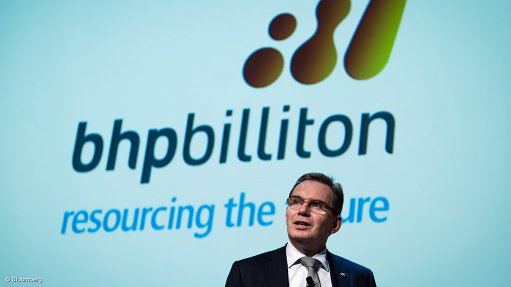
Andrew Mackenzie
Photo by: Bloomberg
PERTH (miningweekly.com) – Despite reporting record production at eight of its operations, in five commodities, mining major BHP Billiton said on Wednesday that the company would maintain its focus on reducing costs.
“Our operational performance over the last six months has been strong. We are reducing costs and improving both operating and capital productivity across the group faster than originally planned,” CEO Andrew Mackenzie said.
“These improvements will help mitigate some of the impact of lower commodity prices, and we remain alert to opportunities to further increase free cash flow.”
Considering the declining commodity markets, BHP had previously flagged some $4-billion in productivity gains between 2014 and 2017, mostly through the spin-off of its aluminium, noncore coal, manganese, nickel and silver assets into an independently listed entity dubbed South32.
Mackenzie said on Wednesday that the company had also moved quickly to respond to lower petroleum prices by reducing the number of shale drilling rigs in the onshore US business by about 40% by the end of this financial year.
The majority of the drilling would now be focused on the Black Hawk acreage, while the company’s dry gas development programme would be reduced to one operated right in the Haynesville, with a focus on continued drilling and completions optimisation, ahead of full field development.
“The revised drilling programme will benefit from significant improvements in drilling and completions efficiency. Our ongoing shale investment programme will remain focused on our liquids-rich Black Hawk acreage,” Mackenzie said.
However, he noted that the company would keep activity at the project area under review, and would implement further changes if it believed that deferring development would create more value than near-term production.
The company also reported that reduced drilling activity would not impact on its 2015 financial-year-end production guidance and that shale liquid volumes would rise by about 50% in the period.
Meanwhile, BHP on Wednesday reported that group production during the six months to December had increased by about 9%.
Iron-ore production during the interim period increased by some 16% on the previous corresponding period, to 113.4-million tonnes, while quarterly production reached 56.3-million tonnes.
Production from the Western Australian operations increased by about 15% during the half-year, to a record 124-million tonnes, as the ramp-up of the Jimblebar mine continued, and BHP improved the availability, use and rate of its integrated supply chain.
Copper production, meanwhile, declined by 4% during the interim period to 813 100 t, while production during the three months ended December reached 423 700 t.
Output from the Escondida operation, in Chile, declined by 2% during the half-year, as a strong operating performance was offset by the impact of water restrictions during the December quarter, along with a two-day industrial action and power outages throughout northern Chile during the September quarter.
Production from the Olympic Dam mine, in South Australia, increased by 4% during the interim period, to 82 000 t of copper.
Total petroleum production for the half-year increased by 9% on the previous corresponding period, to 131-million barrels of oil equivalent, while quarterly production was up 10% to 63.6-million barrels of oil equivalent.
BHP noted that onshore US volumes increased by 71% during the interim period to a record 24.4-million barrels of oil equivalent. The increase was underpinned by continued momentum at Black Hawk and Permian, where liquids production increased by 81% and 107% respectively.
Metallurgical coal production was up 21% on the previous interim period, to 26.3-million tonnes during the six months to December, and up to 13.5-million tonnes during the second quarter.
The increase in metallurgical coal production was achieved on the back of record production from the Queensland coal and Illawarra coal operations during the period under review.
Energy coal production, however, was down by 3% during the half-year ended December, to 36.4-million, while quarterly production was up 5% to 18.6-million, compared with the previous corresponding period.
Looking ahead, BHP maintained its production guidance for all its commodities for the full 2015, with the miner saying on Wednesday that it was on track to deliver group production growth of 16% over the two years ending 2015.